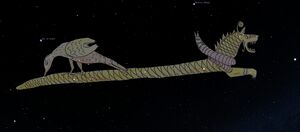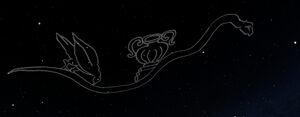Crater
The constellation crater was created in antiquity, probably due to wordplay. It is unknown whether it happened intentionally or unintentionally. The constellation forms part of the ancient Greek super-constellation of Hydra-Corvus-Crater. As such it is mentioned by Aratus, Eratosthenes, Hipparchus and Ptolemy (and all Greek authors from Hellenistic time on). Greek mythology connects it to the adjacent constellations Hydra and Corvus, more details on mythology in Ian Ridpath's Star Tales.
Etymology & History
No Babylonian Predecessor
The pun which created the constellation
McHugh (2016) uses the term MUŠ stating that this Sumerian word has the Akkadian counterpart ``ṣēru'' (also meaning the snake). However, the Akkadian word ``ṣēru'' is a homonym, i. e. it has two meanings: it can denote a snake or a ceramic jug for wine. This way, astronomers from other cultures (e.g. the Mediterranean ones) could have confused the ṣēru (snake) with the ṣēru (crater) and thus put a crater on the back of Hydra. Compellingly, there is also a preposition ṣēru which means ``on top of, upon''. McHugh (2016, 87-88) therefore, produces the phrase ``wine-bowl on top of the water-snake'' from the term MUŠ.
Kechagias and Hoffmann (2022) agree with the first idea concerning the homophony but reject the latter part: "the intercultural misunderstandings of a Sumerian word to transform a special deity to a usual Water-Snake and of a homophonous Akkadian term to change a snake into a wine-bowl, are rather convincing. In contrast, deriving the presence of a raven at the snake's tail from cuneiform wordplays is considered unnecessary."
Depiction of Crater in Antiquity
The snake-like constellation called Hydra in Greek uranology used to be considered a straight line of stars at the celestial equator in the Sumerian and early Babylonian culture. It is depicted as a straight snake-body until the Seleucid period, particularly on the microzodiac clay tablets VAT 7847 and AO 6448. This traditional view is also represented on the preserved Greek silver globe (Galérie Kugel, Paris).
The super-constellation "Hydra+Corvus+Crater" is depicted on the other two globes preserved from Greco-Roman antiquity. On the marble Farnese Globe dated to Hellenistic times, the Hydra snake has a dip towards the south, forming a vessel for the smaller sub-constellations of Crater and Corvus. This depiction is reproduced in Roman and mediaeval images, possibly originally depicting the pun that the "snake" simultaneously "is" the jar it contains.
Greco-Roman Texts
Aratos
[448?] Midway on its coiling form is set the Crater, and at the tip the figure of a Raven [Corvus] that seems to peck at the coil.
[520?] the dim-lit Crater and the Crow
[600?] The Hydra rises higher as far as Crater,
(Kidd 1997)
Pseudo-Eratosthenes
Hipparchus
Geminos
Ptolemy's Almagest Κρατήρ
| Greek
(Heiberg 1898) |
English
(Toomer 1984) |
ident. | |
|---|---|---|---|
| Κρατῆρος ἀστερισμός | |||
| ὁ ἐκ τῇ βάσει τοῦ Κρατῆρος κοινὸς τοῦ Ὕδρου. | The star in the base of bowl, which is [applied in] common to Hydra | alf Crt | |
| τῶν ἐν μέσῳ τῷ Κρατῆρι β ὁ νοτιώτερος | The southernmost of the 2 stars in the middle of the bowl | gam Crt | |
| ὁ βορειότερος αὐτῶν | The northernmost 'of them | del Crt | |
| ὁ ἐπὶ τῆς φοτίου περιφερείας τοῦ στόματος. | The star on the southern rim of the mouth | zet Crt | |
| ὁ ἐπὶ τῆς βορείου περιφερείας. | The star on the northern rim | eps Crt | |
| ὁ ἐπὶ τοῦ φοτίου ὡτίου | The star on the southern handle | eta Crt | |
| ὁ ἐπὶ τοῦ βορείου ὠτίου | The star on the northern handle | tet Crt | |
| ἀστέρες ξ μεγέθους δ΄. | 7 stars of fourth magnitude |
Transfer and Transformation
Weblinks
- Ridpath, Ian, “Star Tales: online edition”.
References
- John McHugh (2016), How Cuneiform Puns Inspired Some of the Bizarre Greek Constellations and Asterisms, Archaeoastronomy and Ancient Technologies, 4(2), 69-100
- Kechagias and Hoffmann (2022). Intercultural Misunderstandings as a possible Source of Ancient Constellations, in Hoffmann and Wolfschmidt (eds.), Astronomy in Culture - Cultures of Astronomy, tredition, Ahrensburg, 205-234
- List of ancient images of the IAU-constellations: https://exopla.net











